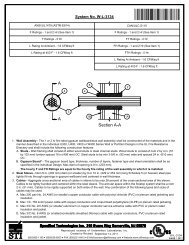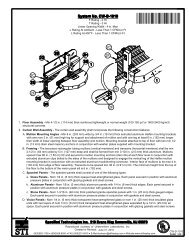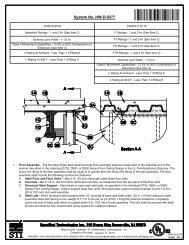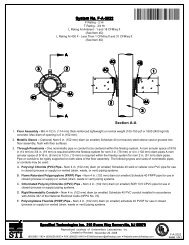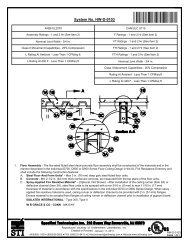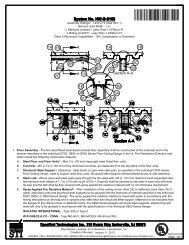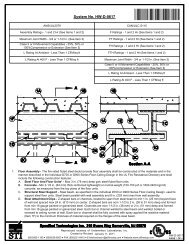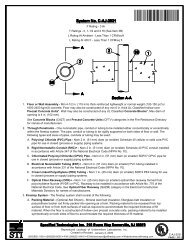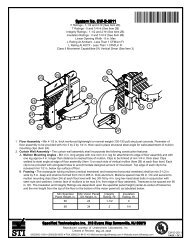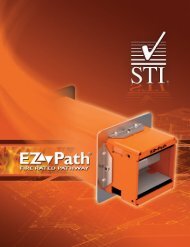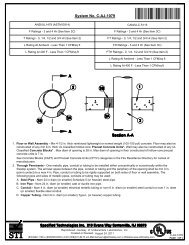R14288 cliv - STI - Specified Technologies Inc
R14288 cliv - STI - Specified Technologies Inc
R14288 cliv - STI - Specified Technologies Inc
You also want an ePaper? Increase the reach of your titles
YUMPU automatically turns print PDFs into web optimized ePapers that Google loves.
of the outlet box in accordance with the instructions supplied with the product.<br />
Installation to comply with the National Electrical Code (NFPA 70). When protective<br />
material is used within outlet boxes on both sides of the wall as directed, the horizontal<br />
separation between outlet boxes on opposite sides of the wall may be less than 24 in.<br />
provided that the boxes are not installed back-to-back. When plastic cover plates are<br />
used, min 3-1/2 in. thick fiberglass (min 0.5 pcf) or mineral wool (min 4.0 pcf) batt<br />
insulation is to be installed within the wall cavity.<br />
SpecSeal Power Shield EP23 Box Inserts, for use with max 2 by 3 by 2-1/4 in. deep<br />
flush device UL Listed Metallic Outlet Boxes without internal clamps installed with steel<br />
extension rings and plastic or steel cover plates in 1 h fire rated gypsum board wall<br />
assemblies framed with either min 3-5/8 in. deep steel studs or min 3-1/2 in. deep wood<br />
studs and constructed of the materials and in the manner specified in the individual U300,<br />
U400 or V400 Series Wall and Partition Designs in the Fire Resistance Directory. Min 3-<br />
1/2 in. thick fiberglass (min 0.5 pcf) or mineral wool (min 4.0 pcf) batt insulation is to be<br />
installed within the wall cavity. One 1-7/8 by 2-3/4 in. insert adhered to the interior back<br />
wall of the outlet box in accordance with the instructions supplied with the product.<br />
Installation to comply with the National Electrical Code (NFPA 70). When protective<br />
material is used within outlet boxes on both sides of the wall as directed, the horizontal<br />
separation between outlet boxes on opposite sides of the wall may be less than 24 in.<br />
provided that the boxes are not installed back-to-back.<br />
SpecSeal Power Shield EP24 Box Inserts, for use with max 2-1/8 by 4 by 2-1/8 in. deep<br />
flush device UL Listed Metallic Outlet Boxes without internal clamps installed with steel<br />
mud rings and plastic or steel cover plates in 1 h fire rated gypsum board wall assemblies<br />
framed with either min 3-5/8 in. deep steel studs or min 3-1/2 in. deep wood studs and<br />
constructed of the materials and in the manner specified in the individual U300, U400 or<br />
V400 Series Wall and Partition Designs in the Fire Resistance Directory. Min 3-1/2 in.<br />
thick fiberglass (min 0.5 pcf) or mineral wool (min 4.0 pcf) batt insulation is to be<br />
installed within the wall cavity. One 1-7/8 by 3-3/4 in. insert adhered to the interior back<br />
wall of the outlet box in accordance with the instructions supplied with the product.<br />
Installation to comply with the National Electrical Code (NFPA 70). When protective<br />
material is used within outlet boxes on both sides of the wall as directed, the horizontal<br />
separation between outlet boxes on opposite sides of the wall may be less than 24 in.<br />
provided that the boxes are not installed back-to-back.<br />
SpecSeal Power Shield EP44 Box Inserts, for use with max 4 by 4 by 2-1/8 in. flush<br />
device UL Listed Metallic Outlet Boxes without internal clamps installed with steel mud<br />
rings and plastic or steel cover plates in 1 h fire rated gypsum board wall assemblies<br />
framed with either min 3-5/8 in. deep steel studs or min 3-1/2 in. deep wood studs and<br />
constructed of the materials and in the manner specified in the individual U300, U400 or<br />
V400 Series Wall and Partition Designs in the Fire Resistance Directory. Min 3-1/2 in.<br />
thick fiberglass (min 0.5 pcf) or mineral wool (min 4.0 pcf) batt insulation is to be<br />
installed within the wall cavity. One 3-3/4 by 3-3/4 in. insert adhered to the interior back<br />
wall of the outlet box in accordance with the instructions supplied with the product.<br />
Installation to comply with the National Electrical Code (NFPA 70). When protective



